1995 GMC SIERRA tires
[x] Cancel search: tiresPage 330 of 488
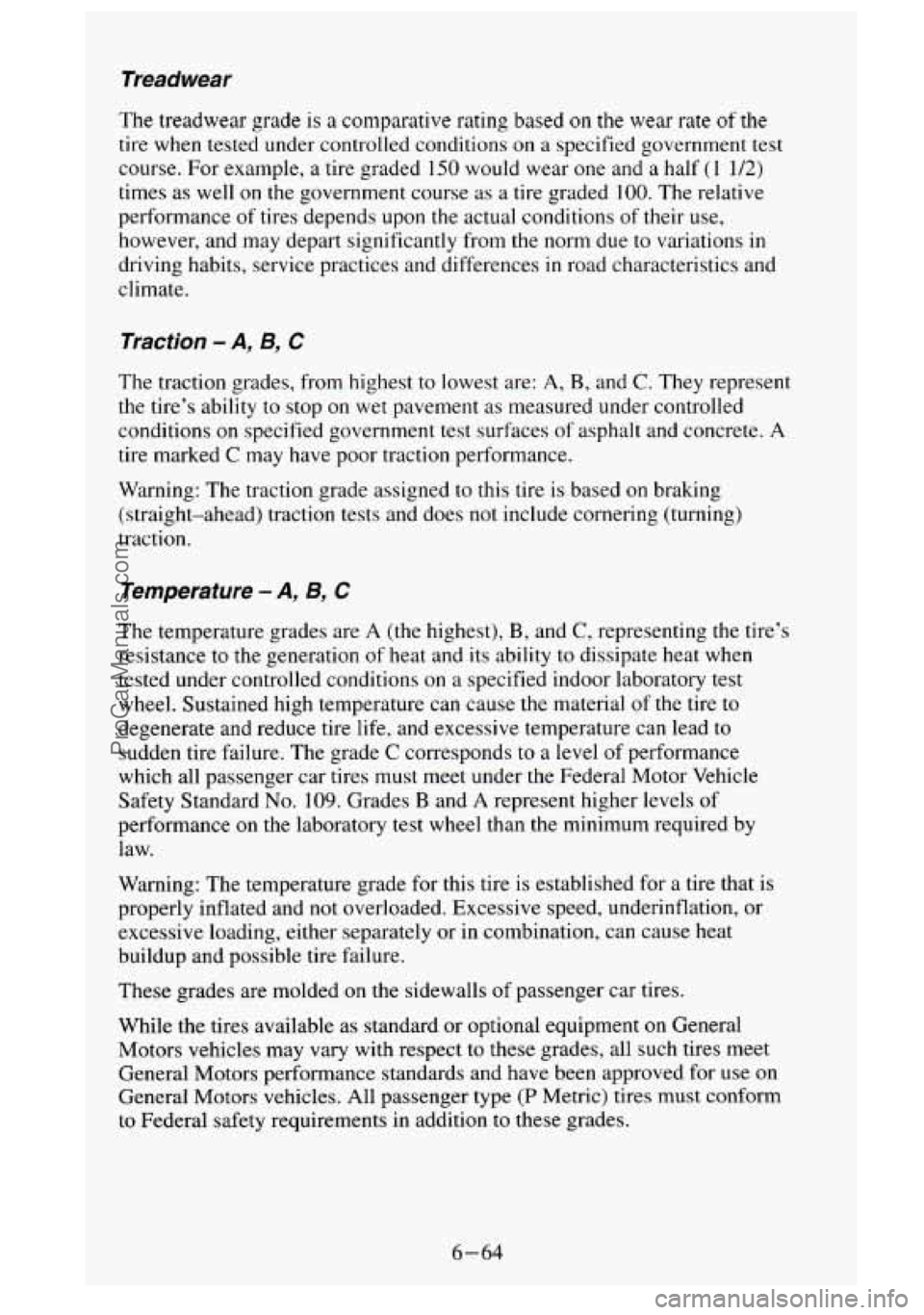
Treadwear
The treadwear grade is a comparative rating based on the wear rate of the
tire when tested under controlled conditions on
a specified government test
course. For example,
a tire graded 150 would wear one and a half (1 1/2)
times as well on the government course as a tire graded 100. The relative
performance
of tires depends upon the actual conditions of their use,
however, and may depart significantly from the norm due to variations
in
driving habits, service practices and differences in road characteristics and
climate.
Traction - A, B, C
The traction grades, from highest to lowest are: A, B, and C. They represent
the tire’s ability to stop on wet pavement
as measured under controlled
conditions on specified government test surfaces of asphalt and concrete.
A
tire marked C may have poor traction performance.
Warning: The traction grade assigned to this tire
is based on braking
(straight-ahead) traction tests and does not include cornering (turning)
traction.
Temperature - A, B, C
The temperature grades are A (the highest), B, and C, representing the tire’s
resistance to the generation
of heat and its ability to dissipate heat when
tested under controlled conditions on a specified indoor laboratory test
wheel. Sustained high temperature can cause the material
of the tire to
degenerate and reduce tire life, and excessive temperature can lead
to
sudden tire failure. The grade C corresponds to a level of performance
which all passenger car tires must meet under the Federal Motor Vehicle
Safety Standard
No. 109. Grades B and A represent higher levels of
performance
on the laboratory test wheel than the minimum required by
law.
Warning: The temperature grade for this tire is established for a tire that is
properly inflated and
not overloaded. Excessive speed, underinflation, or
excessive loading, either separately or in combination, can cause heat
buildup and possible tire failure.
These grades are molded on the sidewalls of passenger car tires.
While the tires available as standard or optional equipment on General
Motors vehicles may vary with respect to these grades, all such tires meet
General Motors performance standards and have been approved for use on
General Motors vehicles.
All passenger type (P Metric) tires must conform
to Federal safety requirements in addition to these grades.
6-64
ProCarManuals.com
Page 331 of 488
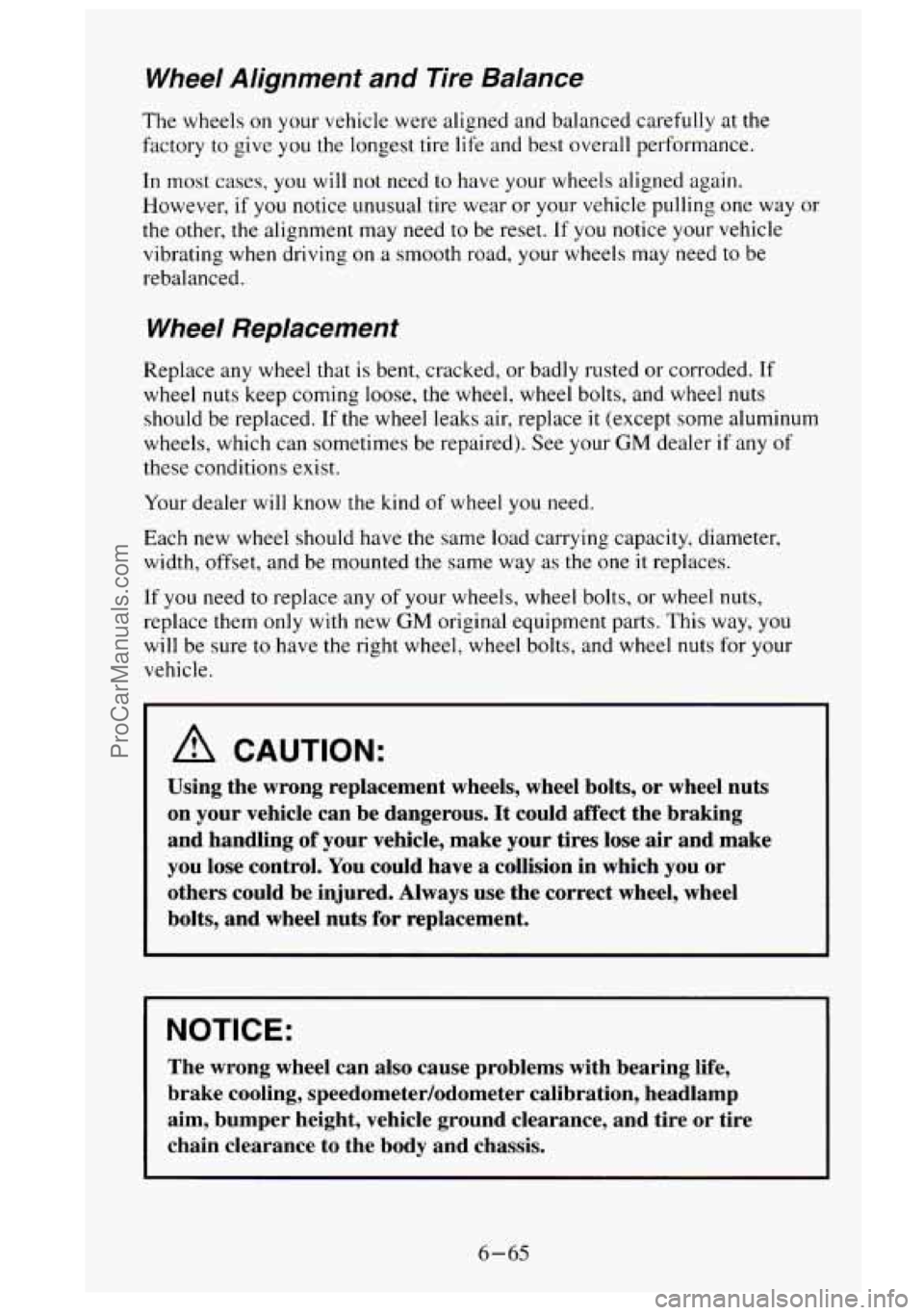
Wheel Alignment and Tire Balance
The wheels on your vehicle were aligned and balanced carefully at the
factory
to give you the longest tire life and best overall performance.
In most cases, you will not need to have your wheels aligned again.
However, if
you notice unusual tire wear or your vehicle pulling one way or
the other,
the alignment may need to be reset. If you notice your vehicle
vibrating when driving
on a smooth road, your wheels may need to be
rebalanced.
Wheel Replacement
Replace any wheel that is bent, cracked, or badly rusted or corroded. If
wheel nuts keep coming loose, the wheel, wheel bolts, and wheel nuts
should be replaced.
If the wheel leaks air, replace it (except some aluminum
wheels, which can sometimes be repaired). See your
GM dealer if any of
these conditions exist.
Your dealer will know the kind of wheel you need.
Each new wheel should have the same load carrying capacity, diameter,
width, offset, and be mounted the same way as the one
it replaces.
If you need to replace any of your wheels, wheel bolts, or wheel nuts,
replace them only with new
GM original equipment parts. This way, you
will be sure to have the right wheel, wheel bolts, and wheel nuts for your
vehicle.
A CAUTION:
Using the wrong replacement wheels, wheel bolts, or wheel nuts
on your vehicle can be dangerous. It could affect the braking
and handling
of your vehicle, make your tires lose air and make
you lose control, You could have a collision in which
you or
others could be injured. Always use the correct wheel, wheel
bolts, and wheel
nuts for replacement.
NOTICE:
The wrong wheel can also cause problems with bearing life,
brake cooling, speedometer/odometer calibration, headlamp
aim, bumper height, vehicle ground clearance, and tire or tire
chain clearance to the body and chassis.
6-65
ProCarManuals.com
Page 332 of 488
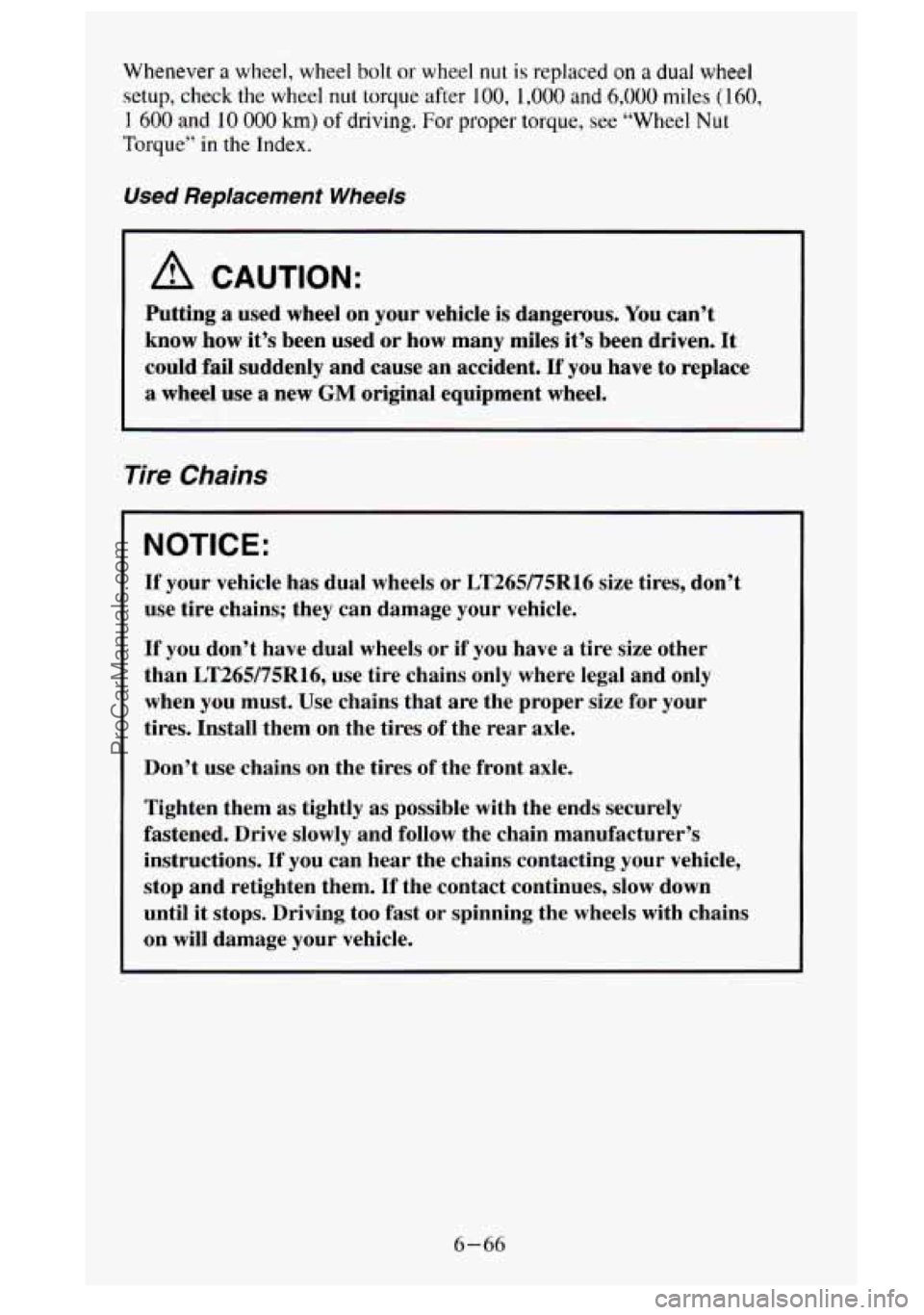
Whenever a wheel, wheel bolt or wheel nut is replaced on a dual wheel
setup, check the wheel nut torque after 100, 1,000 and 6,000 miles ( 160,
1 600 and 10 000 km) of driving. For proper torque, see “Wheel Nut
Torque” in the Index.
Used Replacement Wheels
A CAUTION:
Putting a used wheel on your vehicle is dangerous. You can’t
know
how it’s been used or how many miles it’s been driven. It
could fail suddenly and cause an accident. If you have to replace
a wheel use a new GM original equipment wheel.
7
c
‘ire Chains
NOTICE:
If your vehicle has dual wheels or LT265/75R16 size tires, don’t
use tire chains; they can damage your vehicle.
If you don’t have dual wheels or if you have a tire size other
than
LT26975R16, use tire chains only where legal and only
when you must. Use chains that are the proper size for your
tires. Install them on the tires of the rear axle.
Don’t use chains on the tires
of the front axle.
Tighten them
as tightly as possible with the ends securely
fastened. Drive slowly and follow the chain manufacturer’s
instructions. If you can hear the chains contacting your vehicle,
stop and retighten them. If the contact continues, slow down
until it stops. Driving too fast
or spinning the wheels with chains
on
will damage your vehicle.
6-66
ProCarManuals.com
Page 339 of 488
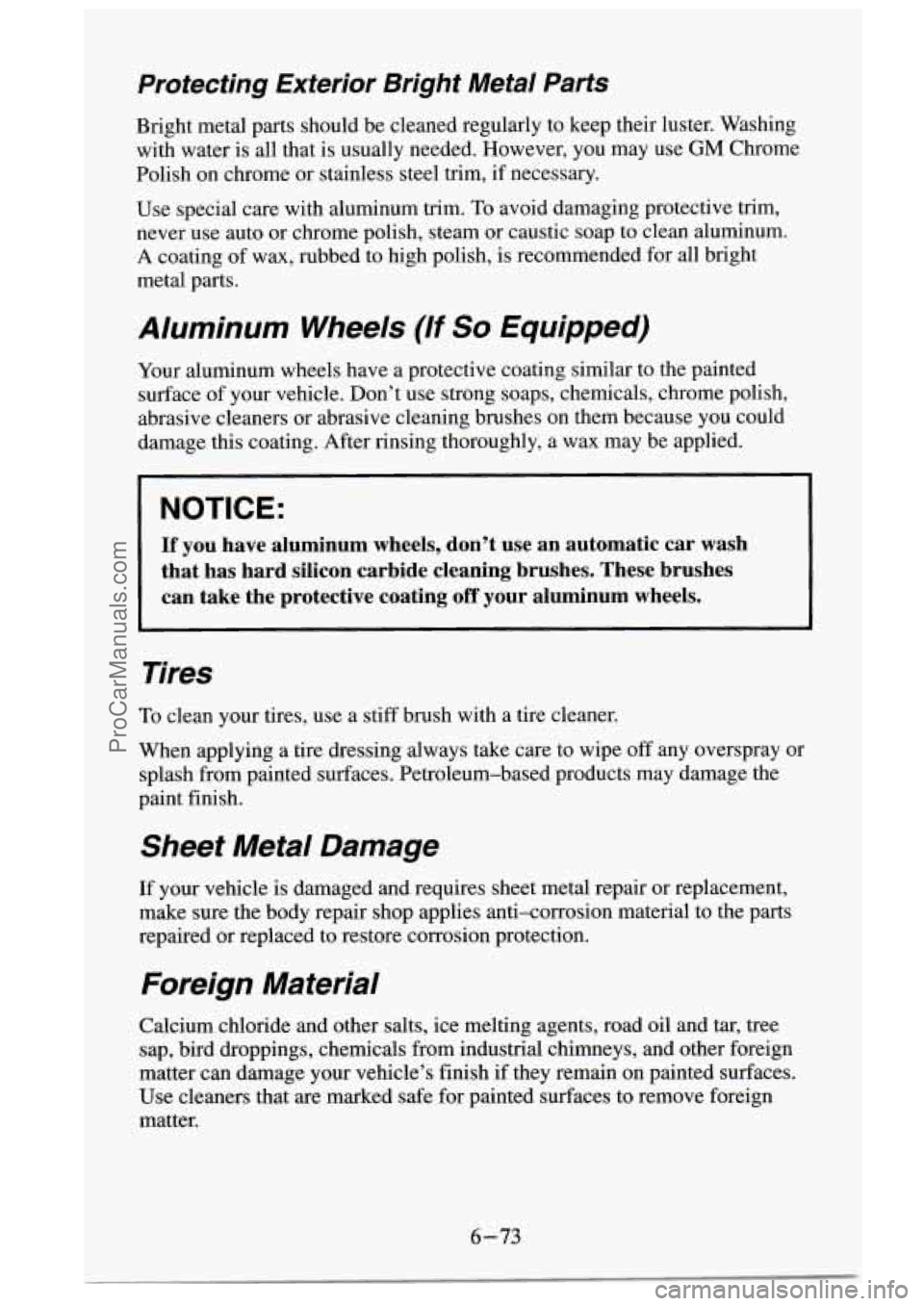
Protecting Exterior Bright Metal Parts
Bright metal parts should be cleaned regularly to keep their luster. Washing
with water is all that is usually needed. However, you may use
GM Chrome
Polish on chrome or stainless steel trim, if necessary.
Use special care with aluminum trim.
To avoid damaging protective trim,
never use auto or chrome polish, steam or caustic soap to clean aluminum.
A coating of wax, rubbed to high polish, is recommended for all bright
metal parts.
Aluminum Wheels (If So Equipped)
Your aluminum wheels have a protective coating similar to the painted
surface of your vehicle. Don’t use strong soaps, chemicals, chrome polish,
abrasive cleaners or abrasive cleaning brushes
on them because you could
damage this coating. After rinsing thoroughly, a wax may be applied.
I NOTICE:
If you have aluminum wheels, don’t use an automatic car wash
that has hard silicon carbide cleaning brushes. These brushes can take the protective coating
off your aluminum wheels.
Tires
To clean your tires, use a stiff brush with a tire cleaner.
When applying a tire dressing always take care to wipe off any overspray or
splash from painted surfaces. Petroleum-based products may damage the
paint finish.
Sheet Metal Damage
If your vehicle is damaged and requires sheet metal repair or replacement,
make sure the body repair shop applies anti-corrosion material to the parts
repaired or replaced to restore corrosion protection.
Foreign Material
Calcium chloride and other salts, ice melting agents, road oil and tar, tree
sap, bird droppings, chemicals from industrial chimneys, and other foreign \
matter can damage your vehicle’s finish if they remain on painted surfaces.
Use cleaners that are marked safe for painted surfaces to remove foreign
matter.
6.- 73
ProCarManuals.com
Page 341 of 488
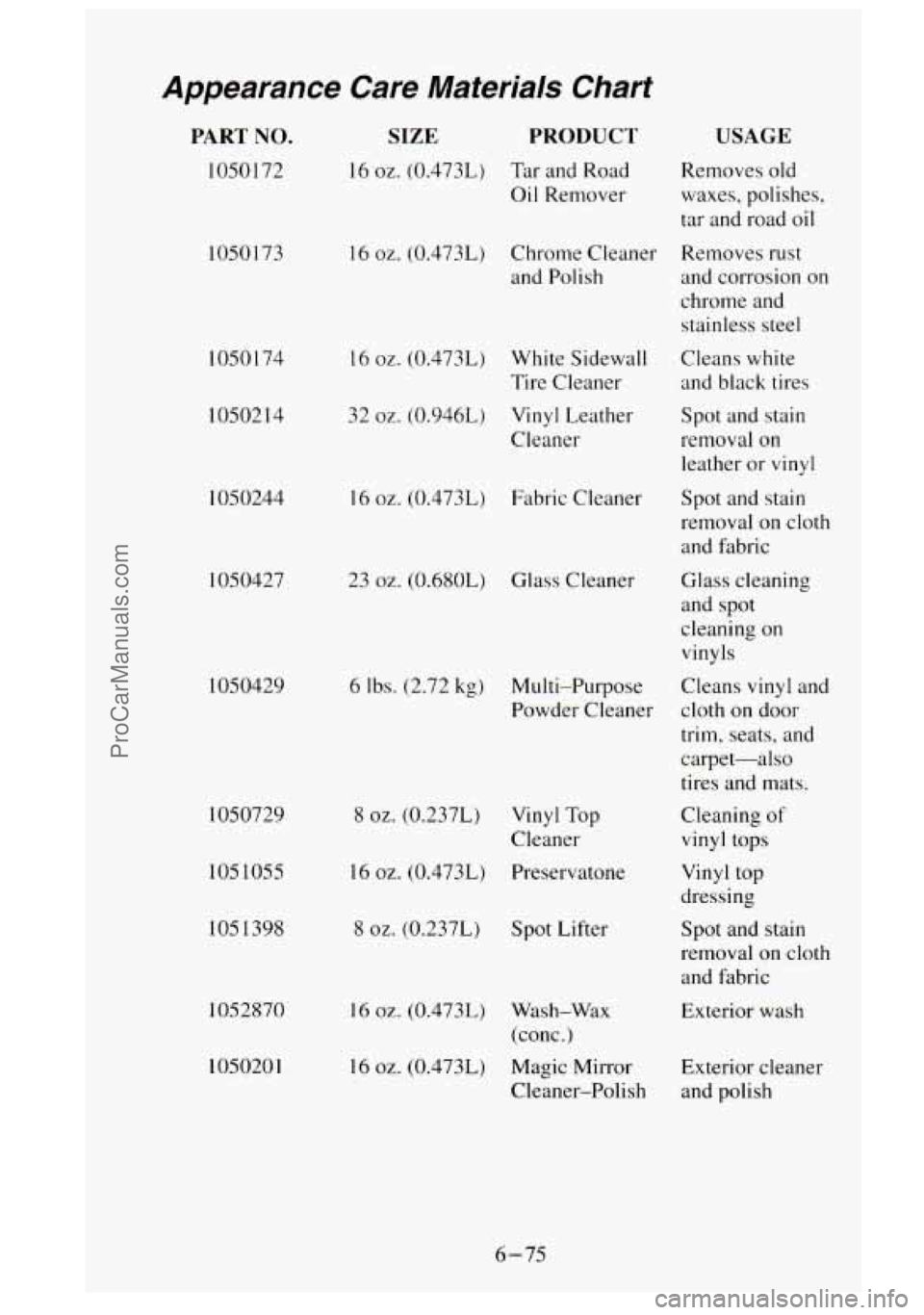
Appearance Care Materials Chart
PART NO.
1050172 1050173
1050 174 10502
14
1050244
1050427
1050429
1050729
1051055 1051398
1052870 105020
1
SIZE
16 oz. (0.473L)
16
oz. (0.473L)
16
oz. (0.473L)
32
oz. (0.946L)
16 oz. (0.473L)
23
oz. (0.680L)
6 Ibs. (2.72
kg)
8 oz. (0.237L)
16 oz. (0.473L)
8 oz. (0.237L)
16 oz. (0.473L)
16 oz. (0.473L)
PRODUCT
Tar and Road
Oil Remover
USAGE
Removes old
waxes, polishes,
tar and road oil
Chrome Cleaner Removes
rust
and Polish and corrosion on
chrome
and
stainless steel
White Sidewall
Tire Cleaner
Vinyl Leather
Cleaner
Fabric Cleaner
Glass Cleaner
Multi-Purpose
Powder Cleaner
Vinyl Top
Cleaner
Preservatone
Spot Lifter
Wash-Wax (conc
.)
Magic Mirror
Cleaner-Polish Cleans
white
and black tires
Spot
and stain
removal on
leather or
vinyl
Spot and stain
removal on cloth and fabric
Glass cleaning
and spot
cleaning on
vinyls
Cleans
vinyl and
cloth on door
trim, seats, and
carpet-also tires and mats.
Cleaning
of
vinyl tops
Vinyl top
dressing
Spot and stain
removal on cloth
and fabric
Exterior wash
Exterior cleaner
and polish
6-75
ProCarManuals.com
Page 370 of 488
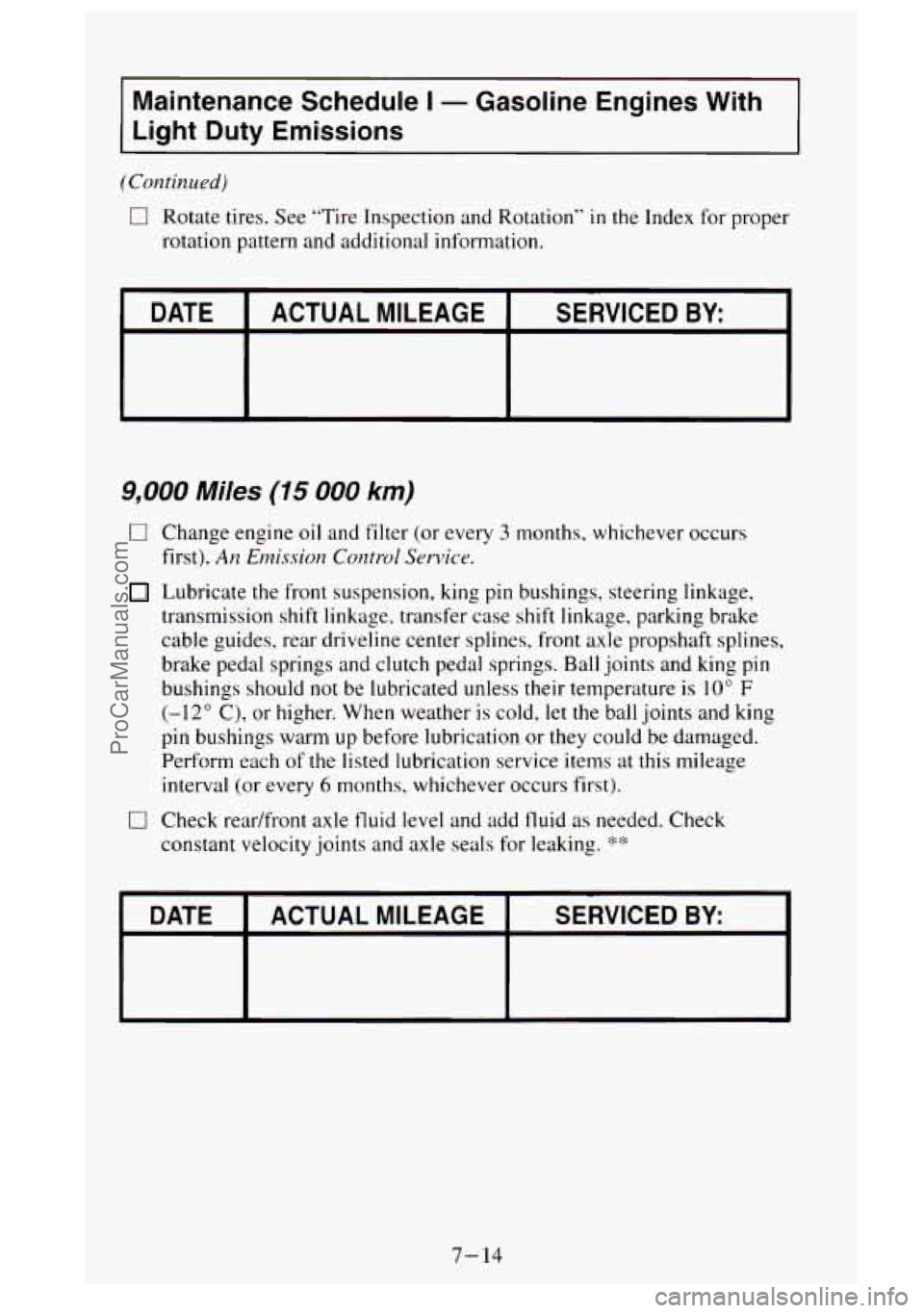
Maintenance Schedule I - Gasoline Engines With
Light
Duty Emissions ~~~~ ~~ ~ ~
(Continued)
0 Rotate tires. See "Tire Inspection and Rotation" in the Index for proper
rotation pattern and additional information.
I DATE I ACTUAL MILEAGE I SERVICED BY:
9,000 Miles (15 000 km)
0 Change engine oil and filter (or every 3 months, whichever occurs
first).
An Emission Control Service.
Lubricate the front suspension, king pin bushings, steering linkage,
transmission shift linkage, transfer case shift linkage, parking brake
cable guides, rear driveline center splines, front axle propshaft splines,
brake pedal springs and clutch pedal springs. Ball joints and king pin
bushings should
not be lubricated unless their temperature is IO" F
(-12" C), or higher. When weather is cold, let the ball joints and king
pin bushings warm up before lubrication or they could be damaged.
Perform each of the listed lubrication service items at this mileage
interval
(or every 6 months, whichever occurs first).
0 Check readfront axle fluid level and add fluid as needed. Check
constant velocity joints and axle seals for leaking.
*'g
DATE SERVICED BY: ACTUAL MILEAGE
7-14
ProCarManuals.com
Page 372 of 488
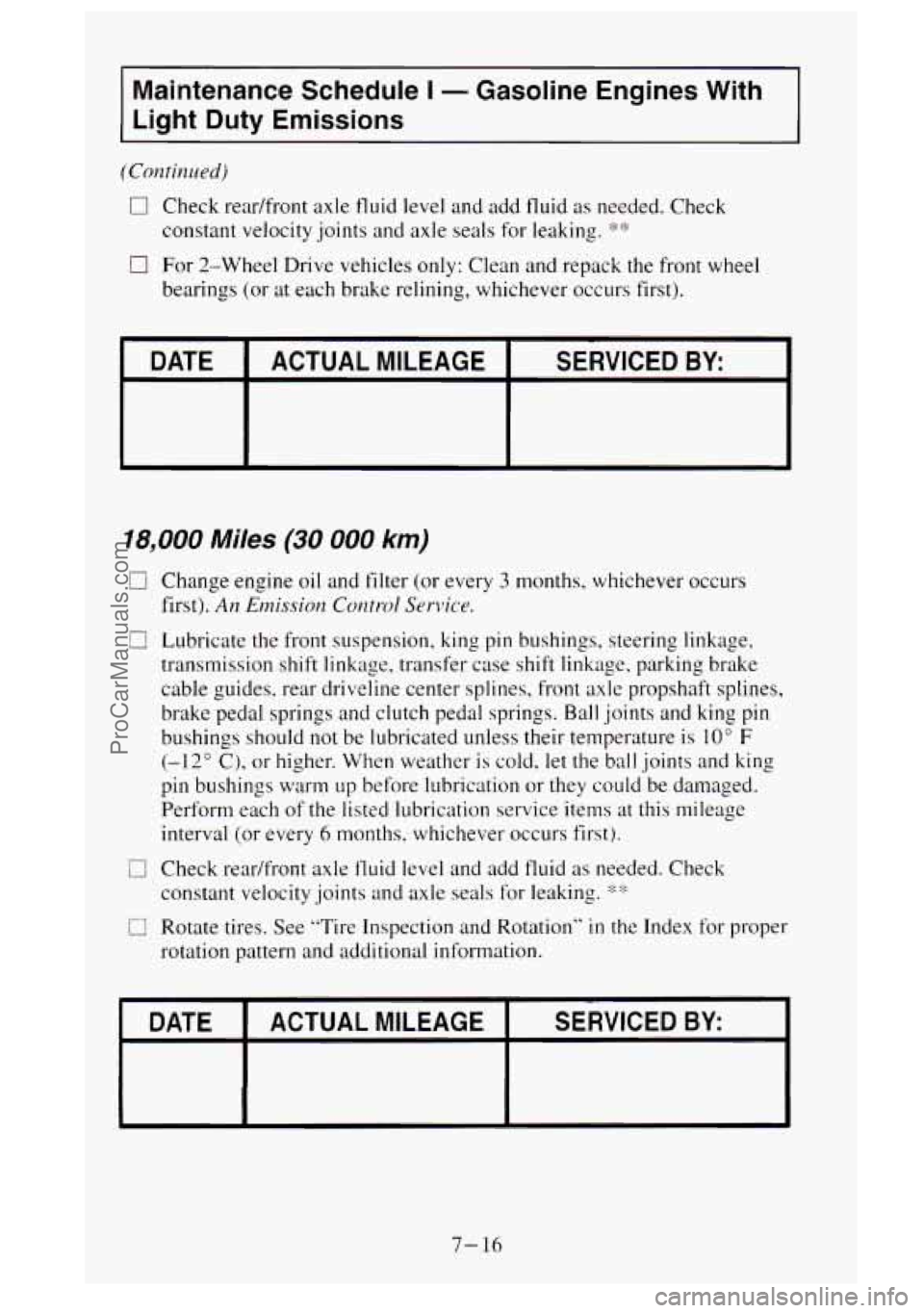
Maintenance Schedule I - Gasoline Engines With
Light Duty Emissions
(Continued)
0 Check rear/front axle fluid level and add fluid as needed. Check
constant velocity joints and axle seals for leaking.
'v'F
0 For 2-Wheel Drive vehicles only: Clean and repack the front wheel
bearings (or at each brake relining, whichever occurs first).
I H I
I DATE I ACTUALMILEAGE I SERVICED BY:
18,000 Miles (30 000 km)
ll Change engine oil and filter (or every 3 months, whichever occurs
first).
An Emission Corltrol Service.
IJ Lubricate the front suspension, king pin bushings, steering linkage,
transmission shift linkage, transfer case shift linkage, parking brake
cable guides. rear driveline center splines. front axle propshaft splines,
brake pedal springs and clutch pedal springs. Ball joints and king
pin
bushings should not be lubricated unless their temperature is 10" F
(-12" C), or higher. When weather is cold. let the ball joints and king
pin bushings warm
up before lubrication or they could be damaged.
Perform each of the listed lubrication service items at this mileage
interval (or every
6 months, whichever occurs first).
c3 Check readfront axle fluid level and add fluid as needed. Check
constant velocity joints and axle seals for leaking.
-&-'&- .> .!,
D Rotate tires. See "Tire Inspection and Rotation" in the Index for proper
rotation pattern and additional information.
DATE SERVICED BY: ACTUAL MILEAGE
7- 16
ProCarManuals.com
Page 375 of 488

LI
c
Maintenance Schedule I - Gasoline Engines With
Light Duty Emissions
(Contimed)
Drain, flush and refill cooling system (or every 24 months, whichever
occurs first). See "Engine Coolant''
in the lndex for what to use.
Inspect hoses. Clean radiator. condenser. pressure cap and neck.
Pressure test
the cooling system and pressure cap. An Emission Control
Service.
For 2-Wheel Drive vehicles only: Clean and repack the front wheel
bearings (or at each brake relining, whichever occurs first).
Replace spark plugs.
An E~~zissior~ Corztrol Ser-vice.
Replace air cleaner filter. Replace filter more often under dusty
conditions.
An Emission Cor~tr-01 Service.
Rotate tires. See "Tire Inspection and Rotation" in the lndex for proper
rotation pattern and additional information.
I DATE I ACTUAL MILEAGE I SERVICED BY:
33,000 Miles (55 000 km)
0 Change engine oil and filter (or every 3 months, whichever occurs
first).
An Er7rissiou Contmi Service.
0 Lubricate the front suspension, king pin bushings, steering linkage,
transmission shift linkage, transfer case shift linkage, parking brake
cable guides, rear driveline center splines, front axle propshaft splines,
brake pedal springs and clutch pedal springs.
Ball joints and king pin
bushings should not be lubricated unless their temperature is
10" F
(-I 2" C), or higher. When weather is cold, let the ball joints and king
pin bushings warm up before lubrication or they could be damaged.
Perform
each of the listed lubrication service items at this mileage
interval (or every
6 months, whichever occurs first).
ProCarManuals.com